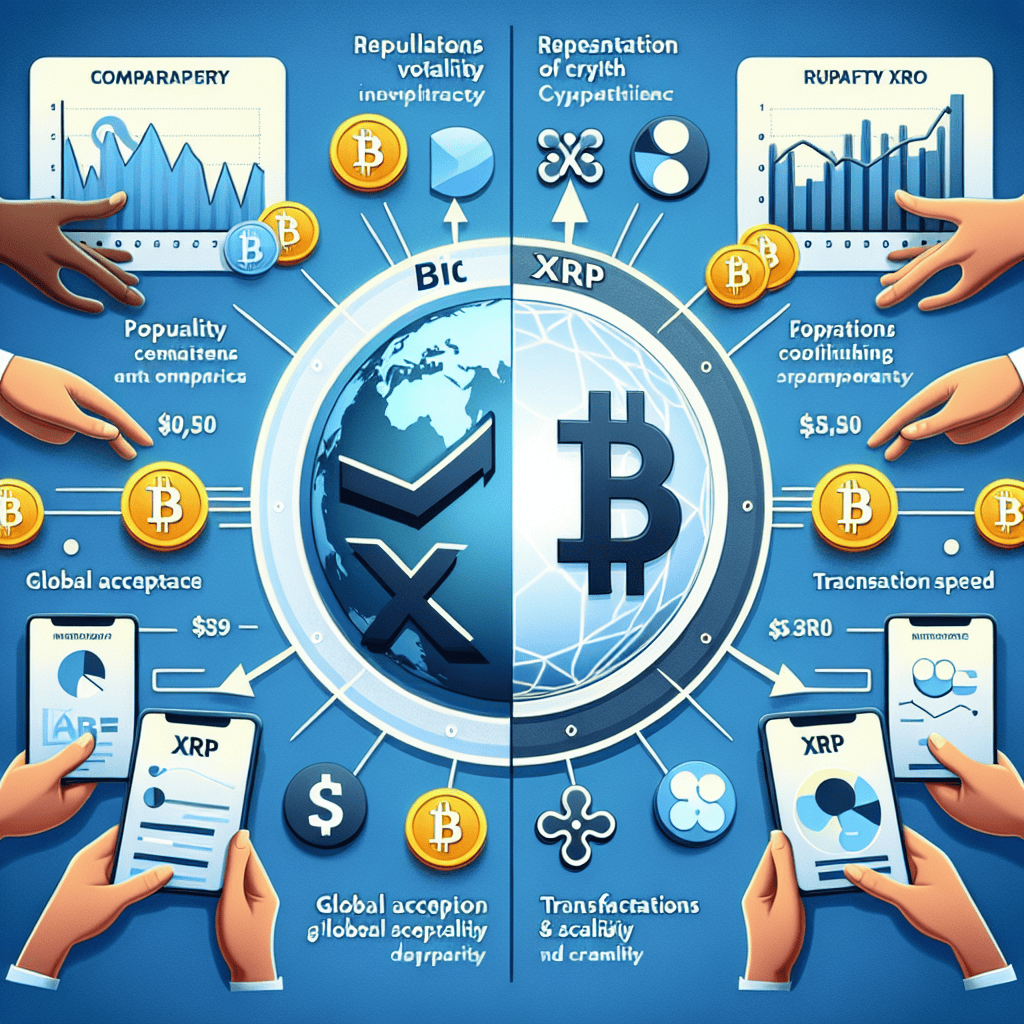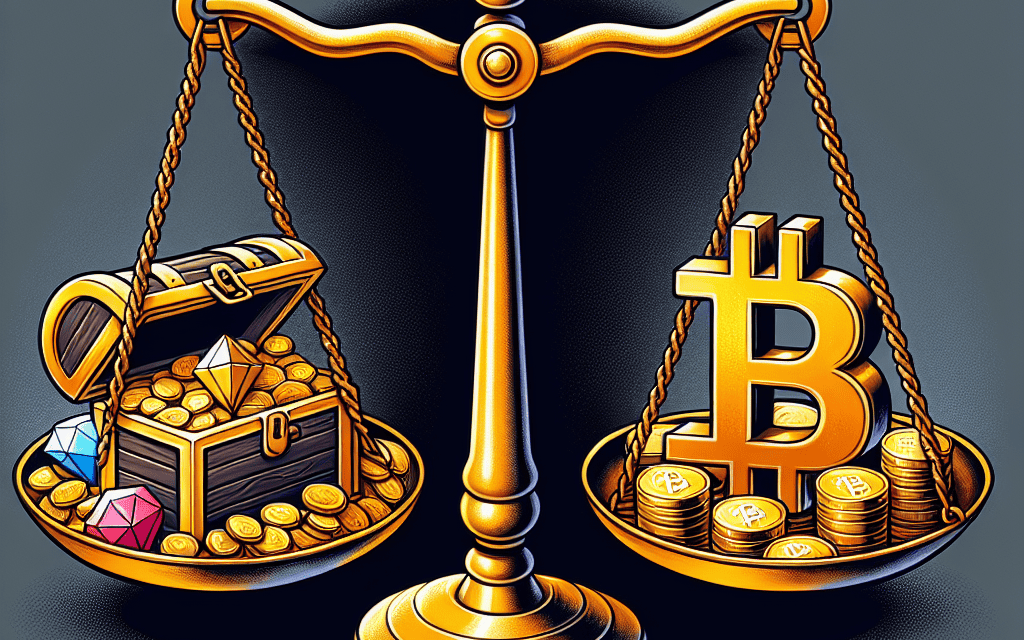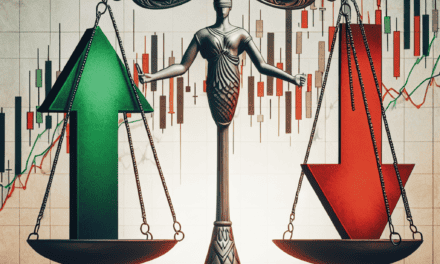“XRP vs. Bitcoin: Navigating the Future of Digital Investments.”
Introduction
When evaluating potential investments in the cryptocurrency market, two prominent names often emerge: XRP and Bitcoin. Bitcoin, the pioneering cryptocurrency, has long been considered the gold standard in digital assets, known for its decentralized nature and limited supply. XRP, on the other hand, is a digital asset associated with Ripple Labs, designed to facilitate fast and cost-effective cross-border transactions. As investors seek to diversify their portfolios and capitalize on the evolving financial landscape, the question arises: Is XRP a better investment than Bitcoin? This inquiry necessitates a comprehensive analysis of various factors, including market performance, technological utility, regulatory environment, and future growth potential, to determine which asset might offer superior returns and align with individual investment strategies.
Comparative Analysis: XRP Vs. Bitcoin Investment Potential
In the ever-evolving landscape of cryptocurrency investments, the debate over which digital asset offers superior potential continues to captivate investors. Among the myriad of options, Bitcoin and XRP frequently emerge as focal points of comparison. As the first and most well-known cryptocurrency, Bitcoin has long been considered the gold standard of digital assets. However, XRP, developed by Ripple Labs, presents a compelling alternative with its unique features and use cases. To determine whether XRP is a better investment than Bitcoin, it is essential to examine several key factors, including their underlying technology, market performance, and potential for future growth.
Bitcoin, introduced in 2009 by the pseudonymous Satoshi Nakamoto, operates on a decentralized network known as blockchain. Its primary appeal lies in its scarcity, with a capped supply of 21 million coins, and its role as a store of value akin to digital gold. Over the years, Bitcoin has gained widespread acceptance and adoption, becoming a household name and a staple in institutional investment portfolios. Its decentralized nature and robust security make it an attractive option for those seeking a hedge against inflation and economic instability.
In contrast, XRP was created with a different purpose in mind. Ripple Labs designed XRP to facilitate fast and cost-effective cross-border transactions, addressing inefficiencies in the traditional banking system. Unlike Bitcoin, XRP does not rely on a proof-of-work consensus mechanism, which allows for quicker transaction times and lower energy consumption. This efficiency has led to partnerships with numerous financial institutions, positioning XRP as a potential disruptor in the global payments industry.
When evaluating the investment potential of XRP versus Bitcoin, market performance is a crucial consideration. Bitcoin’s historical price trajectory has been marked by significant volatility, with dramatic peaks and troughs. Despite this, it has consistently demonstrated resilience, recovering from downturns and reaching new all-time highs. This track record has instilled confidence in investors, reinforcing Bitcoin’s status as a long-term investment.
XRP, on the other hand, has experienced its own share of volatility, compounded by regulatory challenges. The ongoing legal battle between Ripple Labs and the U.S. Securities and Exchange Commission (SEC) has cast a shadow over XRP’s market performance. However, some investors view this as an opportunity, speculating that a favorable resolution could lead to substantial price appreciation. Moreover, XRP’s utility in facilitating cross-border payments could drive demand, particularly if Ripple’s partnerships with financial institutions continue to expand.
Looking to the future, both Bitcoin and XRP face distinct opportunities and challenges. Bitcoin’s widespread recognition and adoption provide a solid foundation for continued growth, especially as more institutional investors enter the market. However, concerns about scalability and environmental impact remain pertinent issues that could influence its long-term viability.
Conversely, XRP’s potential hinges on its ability to navigate regulatory hurdles and capitalize on its utility in the financial sector. If Ripple can successfully address these challenges, XRP may emerge as a formidable player in the cryptocurrency space, offering investors a unique value proposition.
In conclusion, determining whether XRP is a better investment than Bitcoin depends on individual risk tolerance, investment goals, and market outlook. While Bitcoin offers a proven track record and widespread acceptance, XRP presents an intriguing alternative with its focus on revolutionizing cross-border payments. Ultimately, investors must weigh these factors carefully, considering both the potential rewards and inherent risks associated with each digital asset.
Market Volatility: How XRP and Bitcoin Differ
In the ever-evolving landscape of cryptocurrency investments, the debate over whether XRP is a better investment than Bitcoin is a topic of considerable interest. Both digital assets have their unique characteristics and appeal to different types of investors. To understand how XRP and Bitcoin differ, particularly in terms of market volatility, it is essential to delve into their fundamental differences and the factors influencing their price movements.
Bitcoin, often referred to as digital gold, was the first cryptocurrency and remains the most well-known and widely adopted. Its decentralized nature and limited supply of 21 million coins have contributed to its perception as a store of value. However, Bitcoin’s market volatility is a double-edged sword. While it offers the potential for significant returns, it also poses substantial risks. Bitcoin’s price is influenced by a myriad of factors, including regulatory news, macroeconomic trends, and technological developments. Consequently, its value can experience dramatic fluctuations within short periods, making it a volatile investment.
In contrast, XRP, the native cryptocurrency of the Ripple network, was designed with a different purpose in mind. Ripple aims to facilitate fast and cost-effective cross-border payments, positioning XRP as a bridge currency in the financial ecosystem. This utility-driven approach distinguishes XRP from Bitcoin’s store-of-value narrative. As a result, XRP’s price movements are often influenced by developments within the Ripple network, partnerships with financial institutions, and regulatory decisions affecting its use case. While XRP is not immune to market volatility, its price tends to be more stable compared to Bitcoin, primarily due to its utility-focused nature.
Transitioning from the fundamental differences, it is crucial to consider how these characteristics impact their respective market volatilities. Bitcoin’s volatility is often exacerbated by its speculative nature. Investors frequently buy and sell Bitcoin based on market sentiment, leading to rapid price swings. This speculative behavior is further amplified by the relatively low liquidity in the cryptocurrency market compared to traditional financial markets. On the other hand, XRP’s volatility is somewhat mitigated by its use case in facilitating real-world transactions. The demand for XRP is driven by its adoption in the financial sector, which can provide a stabilizing effect on its price.
Moreover, the regulatory environment plays a significant role in shaping the volatility of both cryptocurrencies. Bitcoin, being decentralized, faces regulatory scrutiny primarily concerning its use in illicit activities and its impact on financial stability. Any regulatory news can lead to significant price movements. XRP, however, has faced its own set of regulatory challenges, particularly with the ongoing legal battle between Ripple and the U.S. Securities and Exchange Commission (SEC). The outcome of this case could have profound implications for XRP’s future volatility and adoption.
In conclusion, while both XRP and Bitcoin present unique investment opportunities, their market volatilities differ due to their distinct characteristics and use cases. Bitcoin’s volatility is largely driven by speculative trading and macroeconomic factors, whereas XRP’s price movements are influenced by its utility in the financial sector and regulatory developments. Investors must carefully consider these factors when evaluating the potential risks and rewards associated with each cryptocurrency. Ultimately, the decision of whether XRP is a better investment than Bitcoin depends on individual risk tolerance, investment goals, and market outlook.
Long-Term Growth Prospects: XRP Compared to Bitcoin
When evaluating the long-term growth prospects of cryptocurrencies, XRP and Bitcoin often emerge as prominent contenders, each with distinct characteristics and potential trajectories. Bitcoin, the pioneering cryptocurrency, has long been regarded as a store of value, akin to digital gold. Its decentralized nature and limited supply of 21 million coins have contributed to its perception as a hedge against inflation and economic instability. Over the years, Bitcoin has garnered significant institutional interest, further solidifying its position as a leading digital asset. However, the question remains: does XRP offer a more promising investment opportunity in the long run?
XRP, the native cryptocurrency of the Ripple network, presents a different value proposition. Unlike Bitcoin, which primarily serves as a store of value, XRP is designed to facilitate fast and cost-effective cross-border transactions. Ripple’s partnerships with financial institutions and payment providers aim to revolutionize the traditional banking system by offering a more efficient alternative to existing remittance services. This focus on utility and real-world application distinguishes XRP from Bitcoin, potentially positioning it for substantial growth as global demand for seamless international transactions increases.
Transitioning to the regulatory landscape, it is crucial to consider how this factor influences the long-term prospects of both cryptocurrencies. Bitcoin has faced regulatory scrutiny, but its decentralized nature and widespread adoption have helped it weather various challenges. In contrast, XRP has been embroiled in legal battles, most notably with the U.S. Securities and Exchange Commission (SEC). The outcome of these legal proceedings could significantly impact XRP’s future, either by clarifying its regulatory status or imposing restrictions that could hinder its growth. Therefore, investors must weigh the potential risks and rewards associated with XRP’s regulatory environment when considering its long-term viability.
Furthermore, technological advancements play a pivotal role in shaping the future of cryptocurrencies. Bitcoin’s underlying blockchain technology, while revolutionary, faces scalability issues that could limit its ability to handle a growing number of transactions. Efforts to address these challenges, such as the Lightning Network, are underway, but their success remains uncertain. On the other hand, XRP’s consensus algorithm allows for faster transaction processing and lower fees, making it more scalable in its current form. This technological edge could provide XRP with a competitive advantage as the demand for efficient payment solutions continues to rise.
In addition to technological considerations, market dynamics and investor sentiment are critical factors influencing the long-term growth prospects of XRP and Bitcoin. Bitcoin’s established reputation and first-mover advantage have contributed to its status as a safe haven asset, attracting both retail and institutional investors. Its price movements often serve as a barometer for the broader cryptocurrency market. Conversely, XRP’s price is more closely tied to developments within the Ripple ecosystem and its adoption by financial institutions. As such, XRP’s growth potential may be more directly linked to the success of Ripple’s strategic initiatives and partnerships.
In conclusion, determining whether XRP is a better investment than Bitcoin in terms of long-term growth prospects requires a nuanced analysis of various factors, including utility, regulatory environment, technological advancements, and market dynamics. While Bitcoin’s status as a store of value and its widespread adoption provide a solid foundation for future growth, XRP’s focus on revolutionizing cross-border payments and its technological advantages offer a compelling case for its potential. Ultimately, investors must carefully assess these elements and their risk tolerance to make informed decisions about their cryptocurrency investments.
Regulatory Impact: XRP and Bitcoin in the Financial Landscape

In the ever-evolving financial landscape, the regulatory environment plays a crucial role in shaping the prospects of cryptocurrencies like XRP and Bitcoin. As investors seek to navigate this complex terrain, understanding the regulatory impact on these digital assets becomes paramount. Both XRP and Bitcoin have distinct characteristics and face different regulatory challenges, which can significantly influence their potential as investment vehicles.
To begin with, Bitcoin, the pioneering cryptocurrency, has long been the focal point of regulatory discussions. Its decentralized nature and widespread adoption have prompted governments and financial institutions to scrutinize its use and implications. Regulatory bodies across the globe have taken varied approaches to Bitcoin, ranging from outright bans in some countries to more accommodating stances in others. This regulatory diversity can create uncertainty for investors, as changes in policy can lead to significant price volatility. However, Bitcoin’s established presence and recognition as a store of value have often helped it weather regulatory storms, maintaining its position as a leading cryptocurrency.
In contrast, XRP, developed by Ripple Labs, presents a different regulatory narrative. Unlike Bitcoin, XRP is not mined; instead, it was pre-mined with a finite supply, and its distribution is controlled by Ripple. This centralized aspect has drawn the attention of regulators, particularly in the United States, where the Securities and Exchange Commission (SEC) filed a lawsuit against Ripple Labs in December 2020. The SEC alleged that XRP was sold as an unregistered security, a claim that Ripple has contested. This legal battle has cast a shadow over XRP, leading to delistings from several exchanges and creating uncertainty about its regulatory status.
Despite these challenges, XRP has continued to find favor in certain quarters, particularly in cross-border payment solutions. Ripple’s partnerships with financial institutions and its focus on facilitating international transactions have positioned XRP as a potential bridge currency. This utility-driven approach could offer a regulatory advantage, as it aligns with the broader trend of integrating blockchain technology into traditional financial systems. However, the outcome of the SEC lawsuit remains a critical factor that could either bolster or hinder XRP’s regulatory standing and, by extension, its investment appeal.
When comparing the regulatory impact on XRP and Bitcoin, it is essential to consider the broader implications for investors. Bitcoin’s decentralized nature and its status as a digital gold have made it a popular choice for those seeking a hedge against inflation and economic instability. Its regulatory challenges, while significant, have not deterred institutional interest, as evidenced by the growing number of Bitcoin-focused investment products and services. On the other hand, XRP’s regulatory hurdles highlight the risks associated with centralized control and ongoing legal disputes. However, its potential utility in the financial sector could offer unique opportunities for investors willing to navigate these complexities.
In conclusion, the regulatory impact on XRP and Bitcoin underscores the importance of due diligence for investors in the cryptocurrency space. While Bitcoin’s established reputation and decentralized framework provide a degree of resilience against regulatory shifts, XRP’s centralized nature and legal challenges present both risks and opportunities. As the regulatory landscape continues to evolve, investors must weigh these factors carefully, considering their risk tolerance and investment goals. Ultimately, whether XRP is a better investment than Bitcoin depends on individual perspectives and the ability to adapt to the dynamic regulatory environment.
Transaction Efficiency: XRP’s Edge Over Bitcoin?
In the ever-evolving landscape of cryptocurrency investments, the debate over which digital asset offers superior value continues to captivate investors and analysts alike. Among the myriad of cryptocurrencies available, Bitcoin and XRP frequently emerge as focal points of comparison. While Bitcoin, the pioneering cryptocurrency, is often lauded for its status as a store of value, XRP is increasingly recognized for its transaction efficiency. This raises the question: does XRP’s transaction efficiency give it an edge over Bitcoin as an investment?
To begin with, it is essential to understand the fundamental differences in the transaction mechanisms of Bitcoin and XRP. Bitcoin operates on a proof-of-work consensus algorithm, which, while secure, is inherently resource-intensive and time-consuming. Transactions on the Bitcoin network can take anywhere from several minutes to an hour to be confirmed, depending on network congestion. This delay is further exacerbated by Bitcoin’s limited block size, which restricts the number of transactions that can be processed at any given time. Consequently, transaction fees can fluctuate significantly, often spiking during periods of high demand.
In contrast, XRP, the native cryptocurrency of the Ripple network, employs a consensus protocol that allows for much faster transaction processing. The Ripple network can handle up to 1,500 transactions per second, with each transaction typically settling in just a few seconds. This efficiency is achieved through a unique consensus algorithm that does not rely on mining, thereby reducing both the time and energy required to validate transactions. Moreover, XRP’s transaction fees are generally lower and more stable compared to those of Bitcoin, making it an attractive option for users seeking cost-effective and rapid transfers.
The implications of these differences are significant for investors considering the potential of XRP as a better investment than Bitcoin. From a transactional perspective, XRP’s speed and cost-effectiveness could position it as a more practical choice for everyday use, particularly in cross-border payments and remittances. This utility is further underscored by Ripple’s strategic partnerships with financial institutions worldwide, which aim to streamline and enhance the efficiency of international money transfers.
However, it is crucial to consider that transaction efficiency is just one of many factors influencing the investment potential of a cryptocurrency. Bitcoin’s value proposition extends beyond its transactional capabilities, as it is often perceived as “digital gold” due to its limited supply and decentralized nature. This perception has contributed to Bitcoin’s widespread adoption as a hedge against inflation and economic uncertainty, factors that continue to drive its demand and price appreciation.
On the other hand, XRP’s centralized nature, with a significant portion of its supply held by Ripple Labs, has raised concerns about its long-term decentralization and regulatory scrutiny. These factors could impact its adoption and, consequently, its investment appeal. Furthermore, the ongoing legal challenges faced by Ripple in the United States add an additional layer of uncertainty for potential investors.
In conclusion, while XRP’s transaction efficiency offers distinct advantages over Bitcoin, particularly in terms of speed and cost, it is essential for investors to weigh these benefits against other critical factors such as market perception, regulatory environment, and overall adoption. Ultimately, the decision to invest in XRP or Bitcoin should be informed by a comprehensive analysis of these elements, taking into account individual investment goals and risk tolerance. As the cryptocurrency market continues to mature, the dynamics between these two digital assets will undoubtedly evolve, offering new insights and opportunities for discerning investors.
Community Support: Bitcoin Enthusiasts Vs. XRP Advocates
In the ever-evolving landscape of cryptocurrency, the debate over which digital asset presents a better investment opportunity is a topic of constant discussion. Among the myriad of cryptocurrencies available, Bitcoin and XRP often find themselves at the center of this debate. While both have their unique attributes and potential for growth, the community support behind each plays a crucial role in shaping their respective futures. Understanding the dynamics of these communities can provide valuable insights into the potential longevity and success of these digital assets.
Bitcoin, often referred to as the pioneer of cryptocurrencies, boasts a robust and passionate community. This community is characterized by its strong belief in the principles of decentralization and financial sovereignty. Bitcoin enthusiasts are typically driven by the vision of a decentralized financial system, free from the control of central banks and governments. This ideological commitment has fostered a community that is not only large but also highly active in promoting Bitcoin’s adoption and development. The Bitcoin community’s influence is evident in the widespread acceptance of Bitcoin as a legitimate form of currency and store of value, with numerous businesses and institutions now accepting Bitcoin payments.
In contrast, XRP, the digital asset associated with Ripple Labs, has cultivated a community that is more focused on the practical applications of blockchain technology in the financial sector. XRP advocates are often drawn to the asset’s potential to revolutionize cross-border payments and improve the efficiency of financial transactions. This community is particularly appealing to those who prioritize utility and real-world application over ideological considerations. The support for XRP is bolstered by Ripple’s partnerships with financial institutions and its efforts to integrate blockchain technology into existing financial systems. This pragmatic approach has garnered a dedicated following that sees XRP as a bridge between traditional finance and the emerging world of digital assets.
Transitioning from the ideological to the practical, it is important to consider how these differing community perspectives impact the investment potential of Bitcoin and XRP. Bitcoin’s community-driven development has led to a decentralized network that is resilient and secure, making it an attractive option for those seeking a long-term store of value. The community’s commitment to maintaining Bitcoin’s decentralized nature ensures that it remains resistant to censorship and external control, which is a significant factor for investors concerned about regulatory risks.
On the other hand, XRP’s community support is closely tied to its adoption by financial institutions and its ability to facilitate fast and cost-effective transactions. This focus on utility and integration with existing financial systems positions XRP as a potentially lucrative investment for those who believe in the future of blockchain technology in finance. However, this reliance on institutional adoption also introduces a level of risk, as regulatory challenges and competition from other blockchain solutions could impact XRP’s growth prospects.
In conclusion, the community support behind Bitcoin and XRP reflects their distinct value propositions and potential as investments. Bitcoin’s community is driven by a commitment to decentralization and financial independence, while XRP’s advocates emphasize practical applications and integration with traditional finance. Ultimately, the decision of whether XRP is a better investment than Bitcoin depends on an investor’s priorities and risk tolerance. By understanding the motivations and strengths of each community, investors can make more informed decisions about which digital asset aligns with their investment goals.
Use Cases: Real-World Applications of XRP and Bitcoin
In the ever-evolving landscape of cryptocurrencies, investors and enthusiasts alike often find themselves comparing the potential of different digital assets. Among the myriad of options, XRP and Bitcoin frequently emerge as focal points of discussion, particularly when evaluating their real-world applications. While Bitcoin, the pioneering cryptocurrency, has long been hailed as a store of value and a hedge against inflation, XRP presents itself as a digital asset with distinct use cases, primarily in the realm of cross-border payments and financial transactions.
To begin with, Bitcoin’s primary use case revolves around its role as a decentralized digital currency. It was designed to function as a peer-to-peer electronic cash system, enabling users to conduct transactions without the need for intermediaries such as banks. Over time, Bitcoin has gained recognition as “digital gold,” a term that underscores its perceived value as a long-term investment and a safeguard against economic instability. This perception is largely driven by Bitcoin’s limited supply, which is capped at 21 million coins, and its decentralized nature, which ensures that no single entity can control or manipulate the network.
In contrast, XRP was created with a different purpose in mind. Developed by Ripple Labs, XRP is designed to facilitate fast and cost-effective cross-border payments. The traditional banking system often involves lengthy and expensive processes for international money transfers, a problem that XRP aims to solve. By leveraging the RippleNet network, financial institutions can use XRP as a bridge currency to settle transactions in real-time, significantly reducing both the time and cost associated with cross-border payments. This capability positions XRP as a valuable tool for banks and payment providers seeking to enhance their operational efficiency.
Moreover, the scalability of XRP is another factor that distinguishes it from Bitcoin. While Bitcoin’s network can handle approximately seven transactions per second, XRP boasts the ability to process up to 1,500 transactions per second. This scalability is crucial for supporting high-volume financial activities and further underscores XRP’s suitability for real-world applications in the financial sector. Additionally, XRP transactions are typically settled within seconds, compared to Bitcoin transactions, which can take several minutes to confirm. This speed is particularly advantageous in scenarios where time-sensitive transactions are essential.
Despite these advantages, it is important to acknowledge the challenges and criticisms faced by XRP. One notable concern is the centralized nature of its governance, as Ripple Labs holds a significant portion of the total XRP supply. This concentration of ownership has led to debates about the true decentralization of the network and the potential for market manipulation. On the other hand, Bitcoin’s decentralized network is maintained by a global community of miners, which contributes to its resilience and security.
In conclusion, the decision of whether XRP is a better investment than Bitcoin ultimately depends on an individual’s investment goals and risk tolerance. Bitcoin’s status as a store of value and its decentralized nature make it an attractive option for those seeking a long-term investment. Meanwhile, XRP’s focus on revolutionizing cross-border payments and its scalability offer compelling use cases for those interested in the financial technology sector. As the cryptocurrency market continues to mature, both assets present unique opportunities and challenges, making it essential for investors to carefully consider their specific needs and objectives when evaluating these digital currencies.
Q&A
1. **Volatility**: XRP generally exhibits lower volatility compared to Bitcoin, making it potentially less risky for conservative investors.
2. **Use Case**: XRP is designed for fast and cost-effective cross-border transactions, while Bitcoin is primarily seen as a store of value and digital gold.
3. **Market Adoption**: Bitcoin has broader market adoption and recognition as the first cryptocurrency, which can influence its long-term investment potential.
4. **Regulatory Environment**: XRP has faced legal challenges, such as the SEC lawsuit, which can impact its investment risk compared to Bitcoin.
5. **Supply**: Bitcoin has a capped supply of 21 million coins, which can drive scarcity and value, whereas XRP has a larger supply with a significant portion held by its parent company, Ripple.
6. **Transaction Speed**: XRP transactions are faster and cheaper than Bitcoin’s, which can be advantageous for certain use cases but may not directly impact investment value.
7. **Community and Development**: Bitcoin has a larger and more active development community, which can contribute to its resilience and innovation over time.
Conclusion
When comparing XRP and Bitcoin as investment options, several factors must be considered. Bitcoin, as the first and most well-known cryptocurrency, has established itself as a store of value and a hedge against inflation, with a large market cap and widespread adoption. Its decentralized nature and limited supply contribute to its appeal as a long-term investment. On the other hand, XRP, developed by Ripple Labs, is designed for fast and cost-effective cross-border transactions, with a focus on facilitating payments between financial institutions. While XRP offers potential for growth due to its utility in the financial sector, it faces regulatory challenges and is more centralized compared to Bitcoin. Ultimately, the decision between investing in XRP or Bitcoin depends on an investor’s risk tolerance, investment goals, and belief in the future utility and adoption of each cryptocurrency. Diversification and thorough research are essential when considering investments in the volatile cryptocurrency market.




